



UN OHRLLS Panel Discussion Vulnerability of LLDCs to external shocks New York, 27 May 2014 Thoughts on designing an external shock vulnerability index for LLDCs Matthias Bruckner Committee for Development Policy Secretariat Department of Economic and Social Affairs United Nations
Outline 1. Designing an ESVI - basic considerations 2. Experience with the economic vulnerability index
Purpose of an ESVI • The purpose of an external shock vulnerability index (ESVI) is to provide early warning to LLDCs. • GA/RES/66/214 • ‘Forward-looking’ vulnerability index • Other purposes of vulnerability indices – Measurement of vulnerability – Identification of countries (e.g., LDC indices) – Development of policies to reduce vulnerabilities
Defining vulnerability • What is vulnerability? • Various definitions exist • Definition used by CDP: • Risk of being harmed by exogenous shocks – Being harmed: negative development impact • Vulnerability is function of: – Magnitude and frequency of shocks – Exposure to shocks – Resilience (Capacity to react to and cope with shocks)
Vulnerability and early warning • Exposure and resilience are critical for understanding vulnerability. • Reducing exposure to shocks and building resilience are important for overcoming vulnerabilities. • Highly policy relevant • Exposure and resilience not only influenced by countries affected, but also by global governance • Reducing shocks is also important • Many shocks cannot be eliminated • This holds in particular at the national level
Vulnerability and early warning • High exposure and low resilience give permanent warning to LLDCs • Warning before shocks occur • Increasing exposure and lower resilience warn about rising vulnerability Ø An ESVI only for early warning could concentrate on shock indicators, but would miss many key vulnerabilities
Coverage of issues • What issues should the ESVI cover? • Shocks specific to LLDCs • Transit shocks • Trade shocks in general (focus of APoA) • Environmental, social, political shocks? • Vulnerabilities are interrelated – Example: Increasing food imports • Increase vulnerability to foreign supply and price shocks on world markets • Decrease vulnerability to domestic weather and climate shocks
Other basic questions • Which countries should the ESVI cover? • Only LLDCs or also other (developing) countries? • Should the ESVI be identical across countries? • Facilitates comparisons and learning • Could exclude issues/data that are important in some countries
Designing an ESVI • General criteria for all components – Methodological soundness – Timeliness – Data availability and reliability – Data comparability • Other general issues – Conversion of indicators into indices • Outlier, ‘skewed’ distributions, … – Aggregation method • Simple average, weighted average, geometric average,… Ø An ESVI needs testing before implementation
Designing and using an ESVI • Usefulness of an ESVI depends only partially on its individual components • Composition of an ESVI matters as well Ø It is important to link an ESVI to policy National level policy processes (development Ø planning, sectoral policies) Regional policies (transit and others) Ø International policy Ø
Economic vulnerability index • The EVI is one of three criteria used by the CDP for identifying LDCs – Other to criteria are national income and human asset index • EVI in place since 1999 – Builds on earlier criteria on economic diversification – Indicators within EVI have evolved over time
Indicators of the LDC criteria
Economic vulnerability index • EVI measures only structural vulnerability – Excludes vulnerability due to current or recent political choices – Linked to purpose of LDC category to provide targeted support • EVI covers mainly trade shocks and environmental shocks (natural hazards, and climate change)
Economic vulnerability index • EVI measures shocks and exposure – General resilience covered by other criteria – Some exposure indicators also cover resilience – Resilience to specific shocks often policy dependent – Shocks are measured at the socio-economic level • Export instability rather than cause of instability (external demand drop, commodity price change, …) • Victims of natural disaster rather than weather or geophysical event statistics
EVI for LLDCs 15
Thank k You Contact: Matthias Bruckner Committee for Development Policy Secretariat Department of Economic and Social Affairs United Nations email: brucknerm@un.org http://www.un.org/esa/policy/devplan

Recommend
More recommend